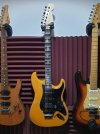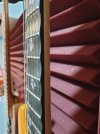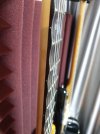Yeah I know they're ugly and you can't play them in tune and if you play a scalloped neck you can't play an unscalloped neck . . . blah blah blah.
Every time I pick up my old mongrel partscaster with the Squier tele neck that I scalloped with a rat tail file a decade ago I got lost in how amazing it feels. The total control over the string, the incredible smoothness of no wood contact, the ease of great vibrato - scallops make it all super easy.
Scallops give you absolute control over the strings. You can completely dominate bends with full confidence that the string is going to do exactly what you tell it to do. Vibrato is easier and more accurate since you never touch the fretboard. Chords to my ears ring a bit clearer and the sound seems to be a smidgen brighter but in a good way. I can play decently without scallops but for most things I prefer them.
Scallops also force you to relax your left hand. After playing scalloped guitars for a while I have far less fatigue and I tend to fret more accurately since there’s no fretboard to stop your finger. It’s not faster really but it
feels faster. You can feel your left hand playing more fluidly and comfortably. After a while that extends to all of your playing.
The only downsides are that you can bend things out of tune if you have a kung-fu grip. That’s a bad habit that scallops will break immediately. I started out trying to imitate Yngwie with 8s tuned down a half step and it did take me a week or so to play in tune. But that’s a pretty gnarly setup. Personally now I run 9s tuned to E standard and E flat with no issues at all.
As far as playing both scalloped and non-scalloped guitars the only thing that I feel when I transition to my regular guitars is an annoying fretboard. Hahaha. It’s no problem at all. It’s actually improved my playing on non-scalloped guitars considerably because of a more relaxed left hand.
Why aren't more guitars scalloped? Is it just the dreaded "guitarists are a bunch of nancies that hate change" issue?
My scalloped partscaster. Like the Millennium Falcon she's ugly but she's got it where it counts.
View attachment 91634
View attachment 91636
View attachment 91635
The body is from an old Strat FSR that I didn’t like the sound of so I used it to practice stripping poly finishes. It was a disaster - it’s a mid 90s Fender 12 piece body with really terrible routing and zero resonance. I was painting a body for my wife so I just threw a couple of coats on this one randomly so my wife could see the color before i painted her real guitar. The finish is rough and the neck pocket is loose as a $10 hooker.
The neck is from an experiment trying to make my own scalloped neck about a decade ago. I took it off of a Squier tele probably 14 years ago that was never quite right. It’s been setting in the garage with no frets literally holding up one end of a workbench. I pulled a set of old Fender frets out of the parts box and pressed them in. I hit the fret ands with my rounding file and did a quick level but I never really took the time to tweak this one.
The electronics, the bridge, the knobs and pretty much all the other parts are literally out of my junk box. The bridge has parts in it from 3-4 guitars - it’s a mix of metric and imperial screws for goodness sake.
But man this guitar just freaking rules. Of course having a set of BKP Trilogy Suites in the pickguard doesn't hurt. Holy fricking crap they are great!
Anyway - why aren't more guitars scalloped from the factory?




